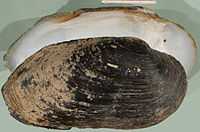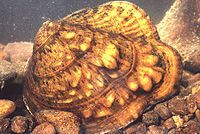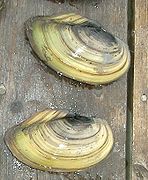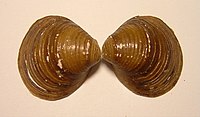Freshwater bivalve
This article includes a list of general references, but it lacks sufficient corresponding inline citations. (October 2018) |
Freshwater bivalves are molluscs of the order Bivalvia that inhabit freshwater ecosystems. They are one of the two main groups of freshwater molluscs, along with freshwater snails.
The majority of bivalve molluscs are saltwater species that live in the marine habitats, but a number of families have evolved to live in fresh water (and in some cases, also in brackish water). These belong to two different evolutionary lineages, i.e. freshwater mussels and freshwater clams, and the two groups are not closely related. Freshwater bivalves have a simple morphology that varies among taxa, and are distributed around most regions of the world.
Freshwater bivalve species vary greatly in size. Some pea clams (genus Pisidium) have an adult size of only 3 mm (0.12 in). In contrast, one of the largest species of freshwater bivalves is the swan mussel from the family Unionidae; it can grow to a length of 20 cm (7.9 in), and usually lives in lakes or slow-flowing rivers. Freshwater pearl mussels are economically important as a source of pearls and mother of pearl. While some species are short-lived, others can be quite long-lived, with some species registering longevity in the hundreds of years. [1]
Freshwater bivalves can thrive in many different types of habitats, ranging from small ditches and ponds to large lakes, rivers, canals and wetlands. The ecology of freshwater bivalves varies among species with regards to differences in reproduction and predation. In spite of their variety of ecosystems, freshwater bivalves are some of the most endangered species on the planet. In North America, for instance, many freshwater mussel species have gone extinct, and of those remaining, 65 percent are rated as endangered, threatened or vulnerable. Droughts, forest clearing, farming, use of dams for water management, and changes in water temperature can all pose threats to freshwater bivalve populations. Restoration efforts focus on rebuilding lost mussel populations in the wild and using those mussels to improve and protect water quality and restore broader ecosystems.[2][3]
Morphology
[edit]External
[edit]Freshwater bivalves, as their name implies, have a protective exoskeleton composed of two half-shells or "valves", connected via a soft ligament along a hinge.[4] These two valves are non-living, composed of both organic and inorganic substances that make up three major valve layers.[4] The first, outermost layer is the thin epidermis (periostracum), followed by a second prismatic layer, containing calcium carbonate.[4] The third and innermost layer is also the thickest and is most commonly referred to as the mother of pearl--- a widely harvested source for the production of ornamental buttons.[4] The external appearances of these shells can be extremely variable when comparing members of different families, genus, etc., as well as intraspecies.[4] Valve surface appearances can range from smooth to dramatically sculpted, showcasing ornamental pustules, pimples, grooves, and ridges.[4] The overall shape of the valve can also vary drastically, from laterally compressed and narrow, to wide and globular.[4]
Internal
[edit]The mantle is a multifunctional, generally thin and fragile structure that line bivalve interiors and encloses their bodies. This structure secretes the shell, contains respiratory organs and facilitates feeding. The cavity that exists between the mantle and other soft tissues is aptly named the mantle cavity.[4]
Within the mantle cavity on either side of the foot are the gills. The inner gills are adjacent to the foot and the outer gills nearest to the mantle and shell. As expected, these gills mainly act as a respiratory structure, performing gas exchange but can also facilitate filter feeding. Water enters the mantle cavity via an incurrent siphon, and passes over the gills where food particles are trapped by secreted mucus.[4]
Anterior and posterior adductor muscles connect the left and right valves, facilitating shell opening and closure.[4] The less major anterior and posterior retractor muscles extend from the shell and attach the body to a structure called the foot.[4] This muscular foot is typical of most bivalves, extending anteriorly between the valves (via an anterior protractor muscle) and aiding in locomotion, burrowing and anchorage (holdfast).[4]
Distribution
[edit]The exact distribution of every freshwater bivalve genera cannot be ascertained because of the lack of data in certain areas of the world like Africa and South America, but freshwater bivalves have been found in all of Earth's biogeographic realms, except for the Antarctic biogeographic realm.[5][6] There are 40 freshwater bivalve representative genera in the Palearctic biogeographic realm, 59 in the Nearctic, 23 in the Afrotropical, 51 in the Neotropical, 47 in the Oriental, 13 in the Australasian, and two in the Pacific Ocean Islands, for a total of 206 freshwater bivalve genera currently identified in the world.[5] Freshwater bivalves are native to the Oriental biogeographic realm and to the southeastern United States and have been introduced to other regions, specifically the two genera in the Pacific Ocean Islands were introduced from Hawaii.[5] As new methods of identifying and locating freshwater bivalves improve, the distribution of where these freshwater bivalves occur can become more apparent.
Taxonomy
[edit]The study of freshwater bivalves predates Aristotle and has since been in a state of constant flux and dispute, regarding their identification and classification.[5] As time has progressed, so too have different techniques and technologies that allow scientists to more comprehensively study the assemblages of organisms in the natural world, freshwater bivalves included. Modern genetic analysis has had major applications in the modern history of taxonomy and has been since utilized in the advancement of freshwater bivalve classification by allowing researchers to identify commonly used genes within these groups.[5] The most commonly used method of identification/classification utilizes an exceptionally diverse set of ever-expanding morphological features, ranging from shell anatomy, variations in internal soft tissue, degrees of mantle fusion, to larval stage development.[5]
Orders and families
[edit]- Arcoida (order)
- Arcidae (family)
- Mytiloida
- Unionida
- Veneroida
- Cardiidae
- Corbiculidae
- Sphaeriidae
- Dreissenidae
- Solenidae
- Donacidae
- Navavulidae
- Myoida
- Corbulidae
- Erodonidae
- Teridinidae
- Anomalodemata
Unionida
[edit]The Unionida, of worldwide distribution, are the pearly freshwater mussels. All reproduce by means of a larval stage that is parasitic on a fish or salamander. Many species are utilized as sources of mother-of-pearl.
Families:
- Order Unionida: pearly freshwater mussels
-
Family Margaritiferidae, a shell of Margaritifera auricularia
-
Family Unionidae, Quadrula metanevra, the monkeyface mussel
-
Family Unionidae, Anodonta cygnea
Veneroida
[edit]The Veneroida is a large group of bivalve "clams", most of which are marine. However, several families occur in fresh and brackish waters.
Families:
- Order Veneroida
-
Family Corbiculidae, shell of Corbicula fluminea
-
Family Sphaeriidae, Sphaerium corneum, one of the small fingernail clams.
-
Family Dreissenidae, Dreissena polymorpha
Reproduction
[edit]Mechanisms
[edit]Freshwater Bivalves can utilize either ovoviviparous or viviparous reproduction strategies, ovoviviparous meaning that embryos develop and grow in eggs inside the female until they are ready to be released. The embryos get nutrition from egg yolk, but are not connected to the mother by a placental connection. Viviparous meaning embryos develop inside the body of a female and usually gain nutrition by a placental connection. Females tend to have a single reproductive spawning period (when the ova moves to the gills) while males tend to have two spawning periods (a release of sperm into the water column).[7] Females have highest ova, or mature female reproductive cells, during September with a gradual decrease until December. Males spawn between September and December with a second spawning period between May and July.[7] Males release their sperm into the water column for females to accept. Females take up the sperm along with water through their circulatory system and have the potential to become fertilized when the sperm meets the ova. In contrast to Marine Bivalves, most female freshwater bivalve species hold the fertilized embryos until they develop into larvae when they are released into the water.[8]
Larvae
[edit]Once larvae are released into the water column they become semi-parasitic and attach to the gills of freshwater fish. They attach to a host where they grow into juvenile adults while doing little to no damage to the fish host.[8] The order Unionidae have an obligate parasitic larval stage where the larvae are attached to the gills, fins or the body of a particular host fish.[5]
Microbial water composition and sediment composition are important in larval nutrition.[9]
Predation
[edit]Invasive species pose a risk to freshwater bivalve populations. Specifically two invasive species of crayfish, Procambarus clarkii and Pacifastacus leniusculus, are predators of the freshwater bivalve species Anodonta anatina.[10] In general, freshwater bivalves have predators such as raccoons, otters, some species of fish, and some species of turtles.
Droughts, floods, and heat waves are a few examples of major climatic events that are happening more frequently because of the global changing climate. This is a huge killer of freshwater bivalve populations.[11]
Ecosystem function
[edit]Freshwater bivalves are important bioindicators of freshwater ecosystems because they are the connection between the water column and the benthos, for they can provide information on the quality of the water based on the particles and toxins that bioaccumulate in the tissue of bivalves.[12] Freshwater bivalves are filter feeders and provide an ecological service by improving water quality in the bodies of water they inhabit, such as rivers, lakes, and wetlands.[5] Water quality is improved by filtering out fine particles of silt, organic matter, and heavy metals as well as bacteria and phytoplankton in the water column to reduce turbidity.[5]
Freshwater bivalves are also important in the process of nutrient cycling because they deposit organic matter in the sediment through biodeposition created from the fine particles they filter in. Organic matter can be deposited in the sediment as feces or dead matter, and depending on if the right environmental conditions are present, such as hypoxia, sediment denitrification can occur, releasing nitrogen back into the atmosphere.[13] However, other organisms are unable to utilize this inorganic form of nitrogen, so freshwater bivalves can also excrete dissolved nutrients in an accessible form for primary producers and consumers to assimilate.[13] Any nutrients that were retained by the freshwater bivalve through its lifespan for building shell tissue can serve as a long-term nutrient storage in the benthos when the organism dies, depending on water chemistry and flow conditions.[13] Considering freshwater bivalves can filter particles and process nutrients in the nutrient cycle, there are other species of freshwater bivalves that have more specialized ecosystem functions as well as different vulnerabilities.
Threats to bivalves
[edit]Invasive species
[edit]
Dreissenidae are a family of freshwater mollusks considered to be an invasive species found across Eurasia and North America.[14] The most common types of dreissenids are Dreissena polymorpha (Zebra mussel) and Dreissena rostriformis (Quagga mussel).[14] These mussels damage both ecological systems and human infrastructure. In North America, biofouling caused by dreissenids created 267 million dollars’ worth of damage between 1989 and 2004.[14] When introduced to freshwater ecosystems, dreissenids lead to a decline in indigenous marine animal populations and are also known for causing benthic algae and cyanobacterial blooms.[14] The total impact of dreissenids on freshwater ecosystems is still unknown.
Anthropogenic impacts
[edit]Pollution, human disturbance, invasive species, and ecosystem modification are the main threats to freshwater bivalves.[15] In North America freshwater bivalves are extremely threatened, with 202 of 300 species considered critical, possibly extinct, or extinct.[15] Of the dangers facing freshwater bivalves, eighty-five percent of them are considered to be “ongoing threats”.[15] Ecosystem modification and pollution are currently the two biggest threats to molluscs and gastropods in Palearctic and Nearctic ecozones.[15] Pollution is the dominant issue for these animals in the Afrotropic and Indomalayan biogeographic realms.[15] For the Neotropics and Australasia biogeographic realms, ecosystem modification has the largest impact on freshwater bivalve species.[15] Hydropower plants and dams are two examples of human ecosystem modification which contributes to loss of habitat as well as changes to channel morphology, river and floodplain connectivity and nutrient limitation.[16] Rates of extinction among freshwater bivalves are higher than those of terrestrial groups which share the same ecosystem.[15] Among those bivalves, freshwater gastropods are the most highly threatened due to smaller species distribution.[15] Freshwater bivalves are at a heightened risk for endangerment and extinction because of the connectivity of river systems.[15] Anthropogenic impacts on rivers spread throughout the whole ecosystem.[15]
References
[edit]- ^ Haag, W.R., and A.L. Rypel. 2011. Growth and longevity in freshwater mussels: evolutionary and conservation implications. Biological Reviews 86: 225–247.
- ^ Levy, Sharon (June 21, 2019). "The hidden strengths of freshwater mussels". Knowable Magazine. doi:10.1146/knowable-062019-1.
- ^ Vaughn, Caryn C.; Hoellein, Timothy J. (2018-11-02). "Bivalve Impacts in Freshwater and Marine Ecosystems". Annual Review of Ecology, Evolution, and Systematics. 49 (1): 183–208. doi:10.1146/annurev-ecolsys-110617-062703. S2CID 91784258. Retrieved 25 June 2021.
- ^ a b c d e f g h i j k l Howells, Robert G.; Neck, Raymond W.; Murray, Harold D.; Inland Fisheries Division, Texas (1996-06-05). Freshwater Mussels of Texas By Robert G. Howells, Raymond W. Neck, and Harold D. Murray. ISBN 978-1-885696-10-6. Archived from the original on 2021-11-02. Retrieved 2020-12-05.
- ^ a b c d e f g h i Bogan, Arthur E. (2008). "Global diversity of freshwater mussels (Mollusca, Bivalvia) in freshwater". Hydrobiologia. 595 (1): 139–147. doi:10.1007/s10750-007-9011-7. ISSN 0018-8158. S2CID 38660332.
- ^ Lopes-Lima, Manuel; Froufe, Elsa; Do, Van Tu; Ghamizi, Mohamed; Mock, Karen E.; Kebapçı, Ümit; Klishko, Olga; Kovitvadhi, Satit; Kovitvadhi, Uthaiwan; Paulo, Octávio S.; Pfeiffer, John M. (2017). "Phylogeny of the most species-rich freshwater bivalve family (Bivalvia: Unionida: Unionidae): Defining modern subfamilies and tribes". Molecular Phylogenetics and Evolution. 106: 174–191. doi:10.1016/j.ympev.2016.08.021. hdl:10198/15272. PMID 27621130. S2CID 4199349.
- ^ a b Beasley, C.R (2000). REPRODUCTIVE CYCLE, MANAGEMENT AND CONSERVATION OF PAXYODON SYRMATOPHORUS (BIVALVIA: HYRIIDAE) FROM THE TOCANTINS RIVER, BRAZIL. Universidade Federal do Pará, Campus de Bragança.
- ^ a b "Developmental Behaviors". www.reed.edu. Retrieved 2020-11-14.
- ^ Sicuro, Benedetto (2015-03-19). "Freshwater bivalves rearing: a brief overview". International Aquatic Research. 7 (2): 93–100. doi:10.1007/s40071-015-0098-6. hdl:2318/1525314. ISSN 2008-4935. S2CID 84793001.
- ^ Meira, Alexandra; Lopes-Lima, Manuel; Varandas, Simone; Teixeira, Amílcar; Arenas, Francisco; Sousa, Ronaldo (2019). "Invasive crayfishes as a threat to freshwater bivalves: Interspecific differences and conservation implications". Science of the Total Environment. 649: 938–948. Bibcode:2019ScTEn.649..938M. doi:10.1016/j.scitotenv.2018.08.341. hdl:10198/17915. ISSN 0048-9697. PMID 30179822. S2CID 52170881.
- ^ Ilarri, M.I.; Souza, A.T.; Sousa, R. (2015-03-01). "Contrasting decay rates of freshwater bivalves' shells: Aquatic versus terrestrial habitats". Limnologica. 51: 8–14. doi:10.1016/j.limno.2014.10.002. hdl:1822/49090. ISSN 0075-9511.
- ^ Lopes-Lima, Manuel; Teixeira, Amílcar; Froufe, Elsa; Lopes, Anabela; Varandas, Simone; Sousa, Ronaldo (2014). "Biology and conservation of freshwater bivalves: past, present and future perspectives". Hydrobiologia. 735 (1): 1–13. doi:10.1007/s10750-014-1902-9. hdl:1822/31319. ISSN 0018-8158. S2CID 8072252.
- ^ a b c Buelow, Christina A.; Waltham, Nathan J. (2020). "Restoring tropical coastal wetland water quality: ecosystem service provisioning by a native freshwater bivalve". Aquatic Sciences. 82 (4): 77. doi:10.1007/s00027-020-00747-7. ISSN 1015-1621. S2CID 224928249.
- ^ a b c d Higgins, S. N.; Zanden, M. J. Vander (2010). "What a difference a species makes: a meta—analysis of dreissenid mussel impacts on freshwater ecosystems". Ecological Monographs. 80 (2): 179–196. doi:10.1890/09-1249.1. ISSN 0012-9615. JSTOR 27806882.
- ^ a b c d e f g h i j Böhm, Monika; Dewhurst-Richman, Nadia I.; Seddon, Mary; Ledger, Sophie E. H.; Albrecht, Christian; Allen, David; Bogan, Arthur E.; Cordeiro, Jay; Cummings, Kevin S.; Cuttelod, Annabelle; Darrigran, Gustavo (2020-09-12). "The conservation status of the world's freshwater molluscs". Hydrobiologia. 848 (12–13): 3231–3254. doi:10.1007/s10750-020-04385-w. hdl:1854/LU-8689344. ISSN 0018-8158. S2CID 224884712.
- ^ Sousa, Ronaldo; Ferreira, André; Carvalho, Francisco; Lopes-Lima, Manuel; Varandas, Simone; Teixeira, Amílcar; Gallardo, Belinda (2020-06-01). "Small hydropower plants as a threat to the endangered pearl mussel Margaritifera margaritifera". Science of the Total Environment. 719: 137361. Bibcode:2020ScTEn.719m7361S. doi:10.1016/j.scitotenv.2020.137361. hdl:10198/21930. ISSN 0048-9697. PMID 32135319. S2CID 212568826.
External links
[edit]- Mollusk Collection at the University of Illinois
- Malacology at the Academy of Natural Sciences of Drexel University
- The Freshwater Mussels (Unionoida) of the World (and other less consequential bivalves) from The Mussel Project
- Rhode Island freshwater clams and mussels by Michael Rice, Rhode Island Sea Grant Fact Sheet






